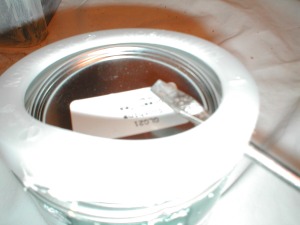I decided to take advantage of some much needed time off of work to tackle a few projects I've been putting off forever, namely painting up the three trash picked bookshelves I have hanging around here. My three day timeline includes two days of priming and painting and the third day to wax the cured paint and style the shelves. Luckily the day-after-Christmas snowstorm we got hit with played perfectly into my plans - I'm not going out in that no way, no how.
So today is day one. Let me introduce you to my
victims shelves:

This first cutie set is actually made from real wood. It's quite scratched on top and an ugly reddish/orangish brown color, but otherwise a nice compact size. It lives in the
cats' hall bathroom and is perect for storing extra towels, toilet paper, books on cats, cat toys, and random cat decor (I plan on becoming a crazy cat lady, complete with theme sweaters, about 20 years from now.)

The next two shelves are a matched pair of laminate complete with cardboard backing. They're also perfectly sized for where they live, one in the dining room in the space between the kitchen door and the wall, which is used to hold barware, dishes, and decorative items, and the other in the master bedroom between the bathroom and closet doors, where it holds a few books, my tax files, and some decorative items.


First I gathered my supplies: A 4" cabinet and door roller set, a canvas dropcloth, foamy brush, angled paint brush, wood glue (to repair the trim on the front of one of the shelves), paint, sanding sponge, and primer. On the recommendation of Kate from
Centsational Girl I picked up the Zinsser oil based primer for the laminate bookcases since it is supposed to stick to anything, and it does.

I sanded the top of the wooden bookcase pretty well since it had some scratches. My wood filler was dried out, so I used a very, very thin coat of plaster spackle to fill in the last little bit and it seems to have worked pretty well. The primer says "no sanding necessary" so I did not sand the rest of the wooden piece, but did go over the laminate ones very lightly (I hate sanding. Detest.). The roller worked really well on the outsides of the bookcases, was a little more difficult on the insides, especially the wooden one whose shelves were not removeable. I used an old foamy brush to get into the corners. I was also working in a really small space which didn't help matters any. The primer dried really quickly (can says an hour, I took a lunch break in there so left it a bit longer).


I tossed the roller after finishing with the primer because I
hate cleaning them did not have the mineral spirits to clean oil paint. Since it was windy as heck and the roads were snow covered, a trip to Home Depot, which is literally across the street, was not in the cards for additional rollers. The interior of the wooden case I decided was more easily tackled with the brush anyway, so I broke out my can of Glidden Soothing Green Tea that I had gotten free about 2 years ago when they did a website promotion. The can was sealed with a plastic ring called a NormLock Seal to keep it from leaking when shipped. I didn't know what it was for or how to get it off, so I started with a websearch. I nearly got a virus, and could have learned how to hack my husband's cell phone or "adult" websites if I'd wanted (I swear my search terms were "opening normlock seal"), but no instructions for getting this plastic ring off my paint can. I found directions for removing a different brand of seal with pliers, so I started there and added a screwdriver when I'd pryed it up enough. Don't worry about destroying it, you're not going to reuse it. This was my main question when starting out - I wasn't sure if it was supposed to go back on the can to scrape the brush against to keep from gooping paint all over the can or what, but no, it is just to seal it for shipping.


So with my paint can open I could finally begin painting! I had planned to do just the inside, and wait until I could get out for rollers to finish up the outside, but once I started I just kept going and did the whole thing. So here is the result.


I'll tackle the laminate shelves tomorrow when I can get out for more rollers. They will both be painted white to match my trim with the back panels in tan to match (or close to match) the walls.

















































